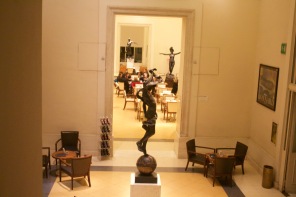Villa Borghese and the Modern City
Of the many public parks in Rome none is better known than the Villa Borghese which comprises nearly 200 acres to the north of the Spanish Steps. Long the property of the wealthy and noble Borghese family, the gardens were purchased by the Italian state after the unification of Italy and make public in 1903 and are today a destination for those seeking green space, but also culture.

Works by Giuseppe Capogrossi at the Galleria Nazionale di Arte Moderna
Many foreign visitors, unaware that the word “Villa” in Italian refers not to a building but to the entire estate, confuse the vast park with the “Casino Nobile” the summer “cottage” created by Cardinal Scipione Borghese in the early 17th century to the designs of Flaminio Ponzio e di Giovanni Vasanzio. This elegant building now hosts the Borghese Gallery, one of the most impressive collections of sculpture and paintings in Italy and, indeed, the world.
But the Borghese Gallery is just the first of many cocktails of nature and art I love to sample and a visit to the Borghese this weekend brought me for the first time in years into one of the least known artistic treasure chests, the Gallery Nazionale di Arte Moderna (or GNAM, which in Italian sounds comically like the word for “yummy” and leads to endless puns about culture and sustenance).
The grand white neoclassical building which hosts Rome’s largest collection of modern art was completed as part of the celebration, in 1911, of the 50th anniversary of Italy’s unification. I once caught a memorable concert by Patti Smith on the steps outside, and visited frequently when I taught a course on the Art of Modernity a few years, back but I haven’t been through its gates since then.
Inside you can spend hours admiring works from the 19th and 20th centuries (for the 21st century, apart from temporary installations of living artists, head over to the nearby MAXXI by Zaha Hadid). Nowhere in Rome is the shift from elegant bourgeois world of the 19th century to the turmoil and liberation of the 20th so compellingly visible. From Canova to Capogrossi, with a good showing of international stars of the likes of Monet, Miro, Mondrian but also Pollock, Twombly, and Kounellis.
Outside the museum, after stopping for a coffee at the wonderful if slightly overpriced Caffe’ delle Arti, take a stroll around the eleven foreign academies with their eclectic architecture and frequent cultural events and installations which will be the topic of another blog post.

New work by Alfredo Pirri in the entry hall of GNAM
Readers of this blog will notice what a change of tone this post brings, induced by my desire to focus on what makes Rome a sustainable city and not just on what holds it back. There will still be plenty of space for comments (leave your own below or on Facebook!) and critique.




